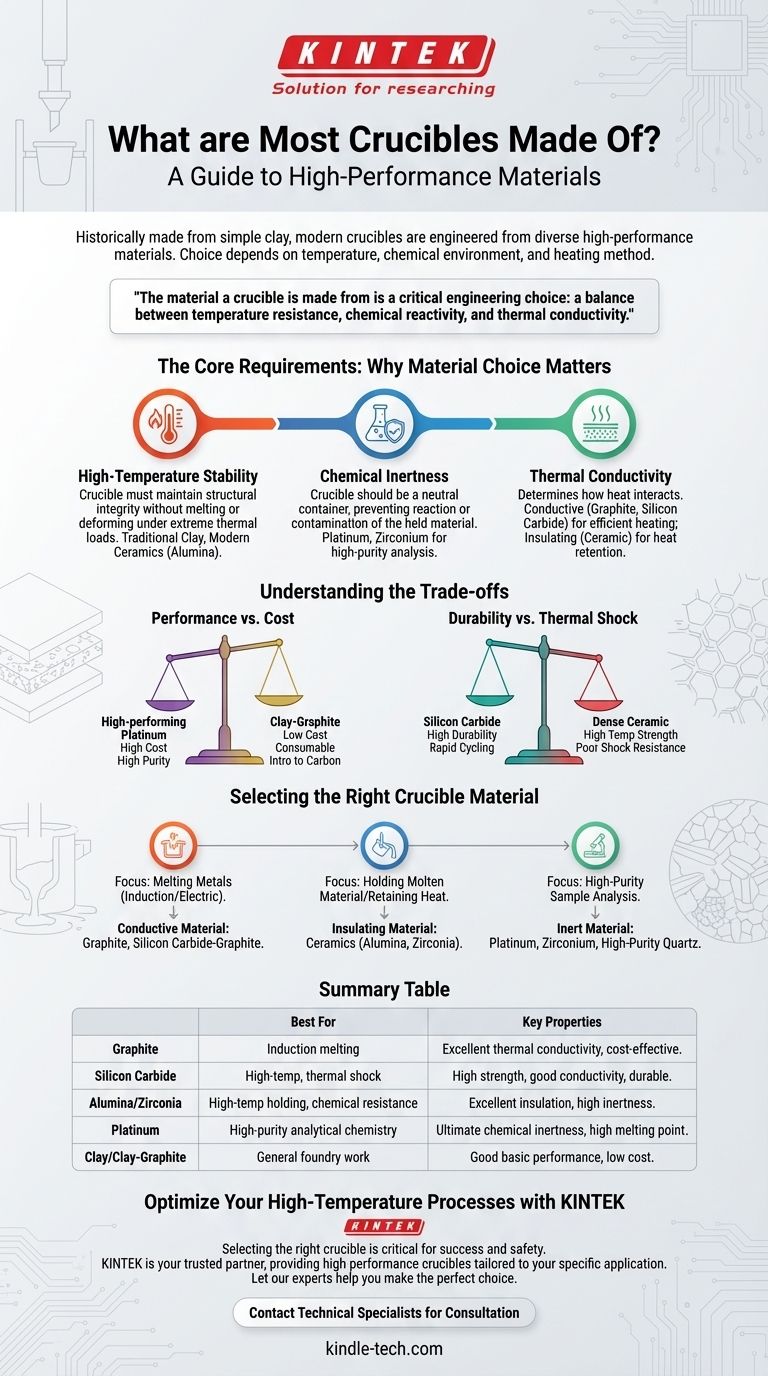Historically made from simple clay, modern crucibles are engineered from a range of high-performance materials chosen for specific tasks. The most common materials today include graphite, silicon carbide, various ceramics like alumina and zirconia, and for highly specialized applications, precious metals like platinum. The choice depends entirely on the temperature, chemical environment, and heating method involved.
The material a crucible is made from is not a matter of general preference but a critical engineering choice. The selection is always a deliberate balance between three key factors: temperature resistance, chemical reactivity, and thermal conductivity.

The Core Requirements: Why Material Choice Matters
A crucible is more than just a high-temperature bowl. Its material is an active component in the process, and choosing the wrong one can lead to failed experiments, contaminated products, or catastrophic equipment damage.
The Foundation: High-Temperature Stability
The most basic requirement for any crucible is the ability to maintain its structural integrity at extreme temperatures. The material must not melt, soften, or deform under the intended thermal load.
While traditional clay and modern ceramics (like alumina) serve this basic purpose well, the exact temperature rating is the first point of specification.
The Purity Factor: Chemical Inertness
A crucible should be a neutral container that does not react with or contaminate the material it holds. This property, known as chemical inertness, is critical.
For high-purity laboratory analysis, contamination can ruin results. This is why expensive but highly inert materials like platinum or zirconium are the standard for analytical chemistry.
In metal casting, a reaction between the crucible and the molten metal can introduce impurities, altering the alloy's final properties.
The Energy Factor: Thermal Conductivity
How a crucible interacts with heat is just as important as resisting it. Materials are broadly categorized as either conductive or insulating.
Conductive crucibles, typically made of graphite or silicon carbide, are designed to allow heat to pass through them efficiently. This is essential for processes like induction heating, where the crucible itself needs to heat up to melt its contents.
Insulating crucibles, usually made of ceramic materials, are designed to prevent heat from escaping. Their purpose is to hold already-molten material and keep it at temperature for as long as possible with minimal energy input.
Understanding the Trade-offs
There is no single "best" crucible material, only the most appropriate material for a specific job. Every choice involves a set of trade-offs.
Performance vs. Cost
The highest-performing materials often come with the highest price tag. A platinum crucible offers unparalleled inertness and a high melting point, but its cost is prohibitive for anything other than small-scale, high-value analysis.
A clay-graphite crucible is far more affordable and suitable for many foundry applications, but it is a consumable that will degrade over time and can introduce carbon into the melt.
Durability vs. Thermal Shock
Thermal shock is the stress a material endures when its temperature changes rapidly. Some materials can crack or shatter if heated or cooled too quickly.
Dense ceramic crucibles may have excellent high-temperature strength but poor thermal shock resistance. Materials like silicon carbide are prized for their ability to withstand rapid temperature cycles, making them more durable in demanding furnace environments.
Selecting the Right Crucible Material
Your choice should be guided directly by your application's primary demand.
- If your primary focus is melting metals in an induction or electric furnace: You need a conductive material, making a graphite or silicon carbide-graphite composite your likely choice.
- If your primary focus is holding molten material and retaining heat: You need an insulating material, pointing you towards ceramics like alumina or zirconia.
- If your primary focus is high-purity sample analysis: You must prioritize chemical inertness, making platinum, zirconium, or high-purity quartz the only correct options.
Ultimately, understanding the properties of the material is the key to mastering your high-temperature process.
Summary Table:
| Material | Best For | Key Properties |
|---|---|---|
| Graphite | Induction melting of metals | Excellent thermal conductivity, cost-effective |
| Silicon Carbide | High-temperature, thermal shock resistance | High strength, good conductivity, very durable |
| Alumina/Zirconia | High-temperature holding, chemical resistance | Excellent insulation, high inertness |
| Platinum | High-purity analytical chemistry | Ultimate chemical inertness, high melting point |
| Clay/Clay-Graphite | General foundry work | Good basic performance, low cost |
Optimize Your High-Temperature Processes with KINTEK
Selecting the right crucible is critical for the success and safety of your lab work or production. The wrong material can lead to failed experiments, contaminated products, and damaged equipment.
KINTEK is your trusted partner for all your laboratory equipment needs. We provide high-performance crucibles tailored to your specific application, whether you're melting metals, conducting high-purity analysis, or need a durable solution for rapid thermal cycling.
Let our experts help you make the perfect choice. We'll ensure you get a crucible that delivers the right balance of temperature resistance, chemical inertness, and thermal conductivity for your process.
Contact our technical specialists today for a personalized consultation and discover how the right crucible can improve your results and efficiency.
Visual Guide

Related Products
- Arc-Shaped Alumina Ceramic Crucible High Temperature Resistant for Engineering Advanced Fine Ceramics
- High Purity Pure Graphite Crucible for Evaporation
- Alumina Al2O3 Ceramic Crucible Semicircle Boat with Lid for Engineering Advanced Fine Ceramics
- Engineering Advanced Fine Ceramics Alumina Al2O3 Crucible With Lid Cylindrical Laboratory Crucible
- Engineering Advanced Fine Alumina Al2O3 Ceramic Crucible for Laboratory Muffle Furnace
People Also Ask
- What is a crucible porcelain? Choosing the Right High-Temperature Lab Vessel
- What temperature can alumina crucible withstand? A Guide to High-Temperature Stability and Safety
- How much heat can a ceramic crucible withstand? A Guide to Material-Specific Temperature Limits
- What is the highest temperature in a crucible? Choose the Right Material for Your High-Temp Application
- How many times can you use a crucible? Maximize Lifespan and Ensure Safety



















